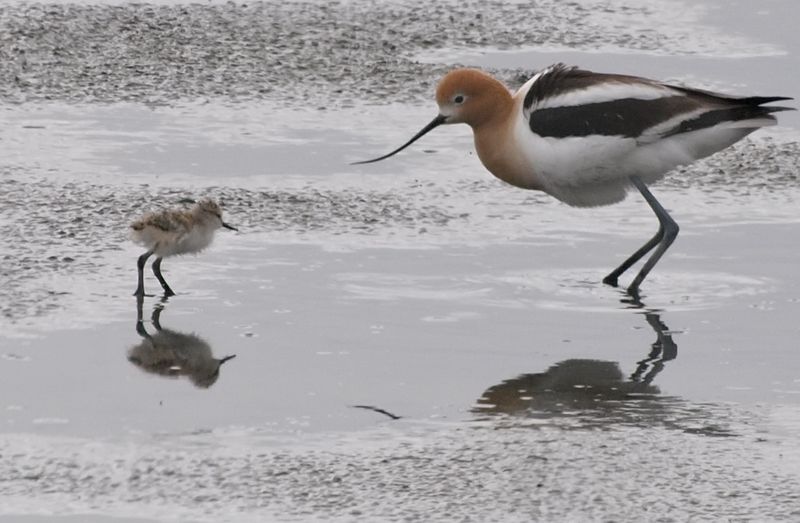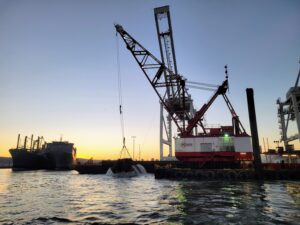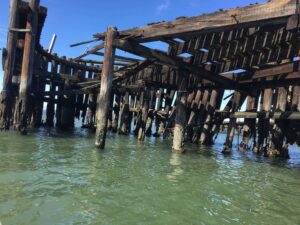English-born geomorphologist Jeremy Lowe is serious about wetlands and serious about mud, though he’s got a wicked sense of humor that shows he’s not taking himself too seriously. We caught up with the senior scientist from San Francisco-based environmental planning firm ESA to discuss why mud is a critical element of the Bay’s ecosystem — and why we should worry about a world where it is in short supply.
BN: Where are you from, originally, and how did you end up in the Bay Area?
I’m originally from England, but I married an American and she lived in the Bay Area. So I moved here in 2000 and never left.
I was doing restoration work in the UK at the time – but it was frustrating because we talked about it a lot in the pub but we didn’t do much about it. Here in the Bay Area, the work is more exciting: There’s a long history of restoration, plus we’ve learned a lot by watching how early sites evolved and we’ve been able to incorporate those lessons into the next generation of restoration projects.
BN: For those of us not in the loop, what does a “senior coastal geomorphologist ” do, exactly?
“Senior” means old, “coastal” means by the sea, “geo” means earth, and “morphology” means shape. We look at the landscape: Why it looks like it does, how it evolves, and how it’s likely to change in the future.
As for the “coastal” part, In Europe I used to work on the open coast and in estuaries, but now I’m mainly doing estuary work in San Francisco Bay, Humboldt Bay, in Puget Sound, and on the Columbia River in Oregon.
BN: Why are estuaries such a critical part of the watershed?
We use the estuaries for a lot of things. We fish in them, use them for transportation, and they help us with flooding events, they clean and filter the water, and support lots of species that we value. Man has changed the landscape over a long period of time; it’s interesting to see how that’s changed. But not all the changes have been for the best – so we’re looking at how to restore the harm that’s been done to the estuaries’ functioning.
BN: Please talk a bit about our Bay in particular.
Cities and freeways have been built where wetlands used to be. But the Bay has been protected so much through the actions of local environmentalists and regulators that what we’re really trying to do now is make a great Bay better.
By contrast, I’ve worked in other places around the world, and Bay Area residents would be horrified by what people have done to their own rivers and estuaries – for example, I worked on a project on the Romanian coast at Costanta on the Black Sea. The swimming beach not only had bathers but also a huge pipe with luminous green gloop spewing out of it courtesy of the local refinery.
But cleaning up our coasts is a struggle: you need awareness, you need regulations, you need cooperation, you need resources, and you need ideas and an eye to the future.
BN: You’ve focused a lot on your work on sediment. What’s so important about mud?
Sediment forms the estuary shape over which the water flows. As it flows it moves the sediment around, eroding and depositing, changing the shape of the estuary, changing its habitats, and altering its functions. The mudflats and salt marshes and beaches of the estuary depend on sediment – mud, sand, gravel.
The problem is that in the past we haven’t thought through the impacts of diking, dredging and damming sediment on the estuary and its habitats; as sea level rises, we need to be wise about how we use our available sediment. We need to value mud as much as we value water.
The trick is how to manage an urban estuary with diminishing sediment supply and increasing water levels, while maintaining its economic dynamism.
BN: I hear concerns that Bay water is getting clearer. Wouldn’t it be better to have clearer water?
Clearer water may indicate a reduction in fine sediment in the Bay, which is a basic building block of mudflats and marshes. We need sediment to help keep up with sea level rise – and what we need to figure out is how much sediment we need, and where.
BN: Where’s your favorite place to go in nature in the Bay Area?
I value the Bay Trail and the ability to get close to the Bay in lots of different places, especially at the Hayward Shoreline and Coyote Hills Regional Park. Even though you’re in the midst of one of the busiest conurbations, you can be completely alone—apart from the jets flying into SFO or Oakland—in the Baylands.
BN: Is there a particular time you like to visit the Bay Trail?
King tides are a really interesting time to visit the Bay as they give you a different perspective of the present marshes and give you a glimpse of what the future might look like. Add some waves and it can get pretty exciting … for a geomorphologist!
Jeremy Lowe will be speaking about mud matters at Friends of Five Creeks’ new “Bay Currents” lecture series at the Albany Community Center on February 3, 2014 from 7:30-9 pm (refreshments will precede the talk at 7 pm).






